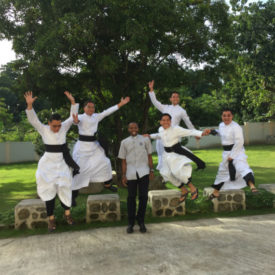Every country brings pieces of its own culture to the Catholic faith, and the Philippines is no different. Catholicism in the Philippines carries with it an especially strong devotion to Mary and the saints. Let’s take a brief look at Catholicism in the Philippines today.
Catholicism in the Philippines
Catholicism arrived in the Philippines with the Spanish in the early 16th century. Today, more than 86% of the population is Roman Catholic. The country has the third largest Catholic population in the world, behind Brazil and Mexico and ahead of the United States. It’s also the only predominantly-Christian country in Asia.
Filipinos have a deep-seated love for the saints, especially the Blessed Virgin Mary. Catholics in the Philippines hold large celebrations for the feast days of various saints. On these special days, Filipinos demonstrate their fondness for public processions and religious statues. Entire towns, including both Catholics and non-Catholics, will join in the celebration of feast days with the local parish church.
Filipinos are communal in their relationship with the Catholic Church, attending services and functions as both a religious and a cultural practice. Because of these integral aspects of community and a corresponding shortage of priests to serve these large communities, parishes are generally quite large, with multiple masses per day. A typical parish in the Philippines has around 10 Masses per weekend. It’s also common for parish priests to travel to multiple local chapels within their vicinity to say mass.
Aside from attending masses and participating in the sacraments, Filipino Catholics get together for novenas, prayer meetings and bible sharing. They tend to be an incredibly active, encouraging and welcoming people when it comes to sharing the Catholic faith.
A Resilient Faith
Generally speaking, churches in the Philippines don’t have the same luxuries or comforts as most Catholic churches in the United States. Air-conditioning and sound and lighting systems are difficult to come by. Instead, masses are celebrated without the help of advanced technology in packed churches with electric fans to help cool down the crowds.
“[T]he Filipinos have this resilient faith that I have not found or seen in many places. They have a way of taking the worst that life can bring and then turn to God and keep smiling and laughing. It is beautiful to see this attitude to the tragedies of life.” Fr. Nnamdi, OMV
The Oblates’ Mission in the Philippines
The U.S. Oblates of the Virgin Mary officially began our mission in the Philippines on the island Cebu in 1997, though we had been giving the spiritual exercises throughout the country since 1994. Currently, there are two Oblate communities: one in Cebu and one in Antipolo. Each is geared toward different stages of the formation of new Oblates. Cebu is also home to our retreat center.
With a shortage of priests and a large population of Catholics, Oblates help the local parishes and chapels with their weekly masses and confessions whenever possible. This is a great help in a diocese like Antipolo, which has less than 200 priests serving close to four million registered Catholics.
Both Oblate communities offer spiritual direction and confessions to the local laity and religious. Our seminarians also travel to local parishes and schools to give the spiritual exercises of St. Ignatius of Loyola. Due to the large size of many of the parishes, parish priests are often consumed with meeting the basic demands of their parishioners. Filipinos know they can come to the Oblates to nurture their faith with retreats, days of recollection, spiritual direction and Confession.
Popularity of Religious Retreats
The culture of the Philippines encourages regular retreats for reflection and celebration. Parishes, schools, businesses and public establishments have annual (or more frequent) retreats. Some schools have even made attendance at their retreat a requirement for graduation.
Although retreats are in high demand, the Oblates come with a unique approach in the Ignatian Exercises. As in many cultures, Filipinos often find silent retreats uncomfortable. They’re used to more lively and entertaining retreats with lots of talks, games, singing and dancing. However, once they can overcome that initial challenge, we’ve seen many Filipino Catholics grow to love our retreats. The Oblates help them learn how to connect with God and to be apostles of Jesus Christ.
From retreats to local parishes, we’re humbled by the privilege of being God’s instruments to bring the people of the Philippines to deeper communion with God.
What aspect of Filipino Catholicism do you most connect with? Do you have additional questions about Catholicism in the Philippines or the Oblates’ mission there? We would be happy to talk with you! Please leave your comments in the box below.


I love the photo or my OMV confreres jumping around and full of joy, under the loving look of Fr Nnamdi, omv
Guy, omv in Montreal, Canada